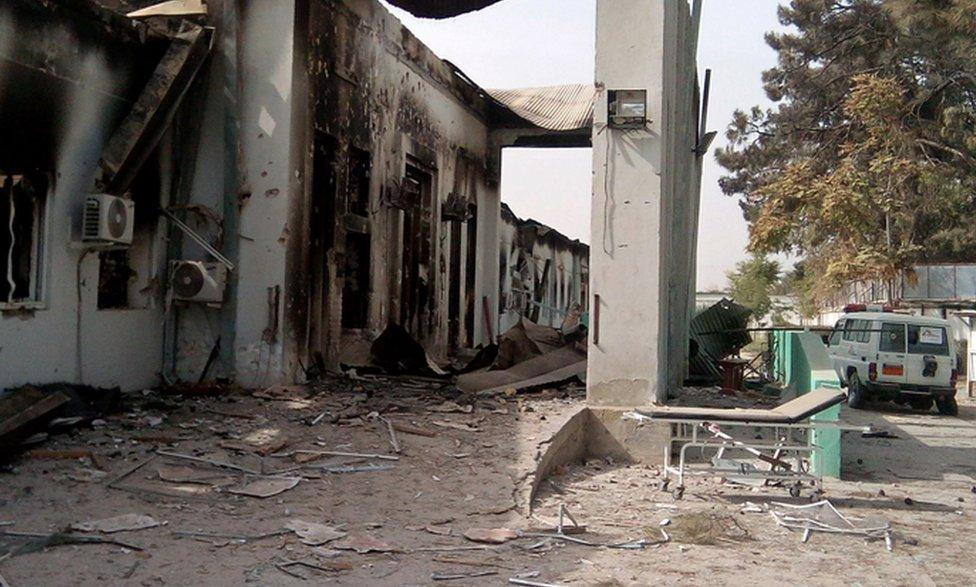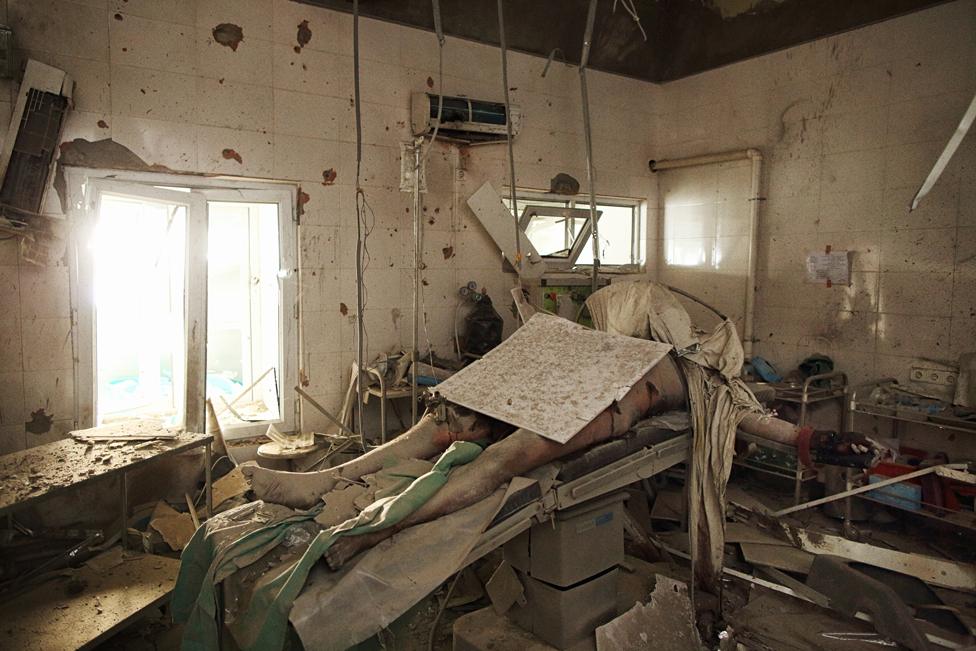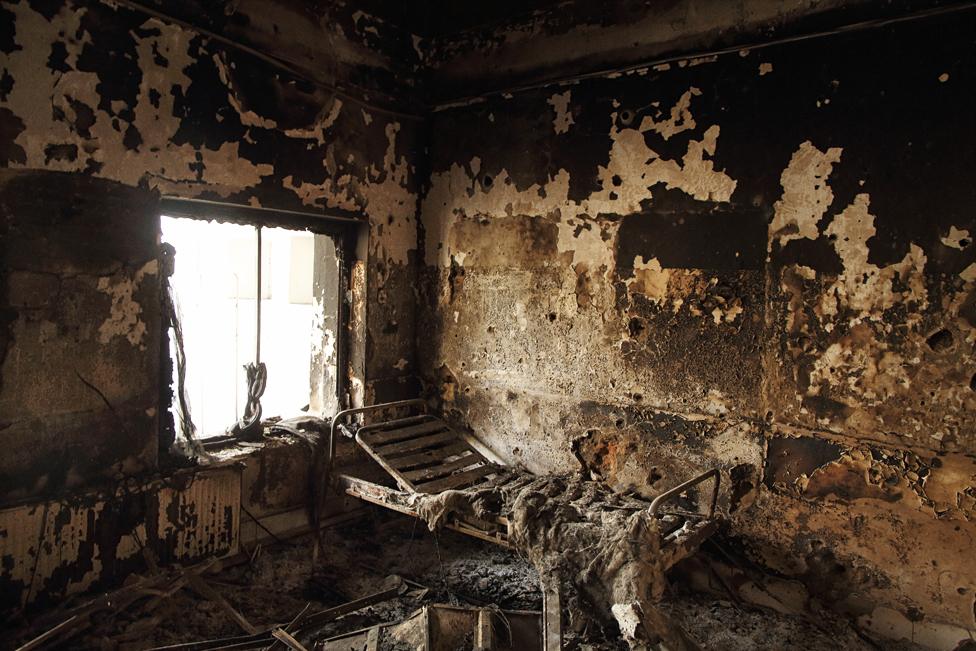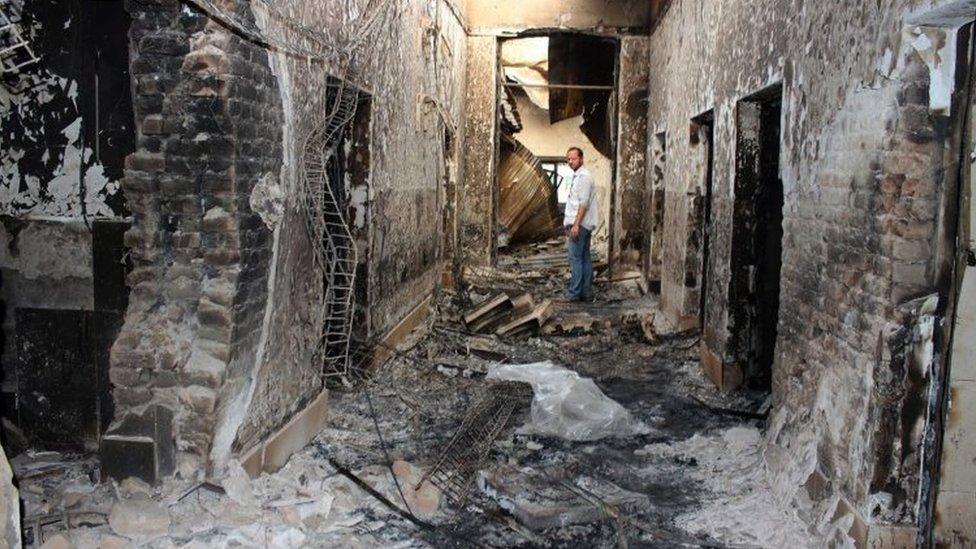Bombed in the Kunduz operating theatre
- Published

In the early hours of 3 October 2015, a US aircraft bombed what crew members thought was a Taliban compound in Kunduz, Afghanistan. It was, in fact, a hospital run by Medecins Sans Frontieres. Surgeon Mohammed Safi Sadiqi was in the middle of an operation. Here he describes what happened. This report contains an image some readers might find disturbing.
That night, there were about six to eight surgeons working in the hospital. We had split into two teams, and we decided that each surgeon should have at least four hours sleep. There were about 390 patients in the hospital, so we were working constantly, non-stop.
It was my team's turn to do the operations - we had scheduled about 40, and when the first bomb struck, I believe we were operating on the 30th or maybe 32nd person.
I was operating on a patient who'd been hit in the leg by a bullet. The injury was not an immediate threat to his life - he could have left the hospital if we had completed the operation.
I was almost finished when the bombing started.
I think the first bomb struck the intensive care unit, just 6m from the operating theatre where I was. When it hit, everything fell off the walls, things were dropping from the ceiling, and the windows blew out.
The lights went out across the hospital. Suddenly a big wooden panel from the ceiling dropped on to the patient on the table, right on top of him. We all ran. I went through the closest door, into the sterilisation room. Some people who chose other routes didn't make it.
I couldn't have done anything for the patient I was operating on. He was under anaesthetic, and we would have needed two or three people to move him. There was no time - there were just seconds to escape before more bombs dropped.

The patient Dr Mohammed Safi Sadiqi was operating on when the hospital was bombed
But I did help another patient - a 12-year-old boy who had managed to escape with us into the sterilisation room.
There were about nine of us in that small room. There was also a guard who came in from outside. He'd been screaming because he was so scared.
It all happened in a very short time, so it was hard to tell what was going on. It was very panicky. It was a matter of life and death.
I can't tell you how many bombs went off, it happened so fast. I saw flashes around the building, and we could hear explosions everywhere. The building caught fire after 10 or 15 minutes.
I was so panicked and so scared that I didn't know what to do. I called my family so I could talk to them and try to forget about what was happening.
I called my elder brother. I told him exactly where I was and said: "I don't know whether I'm going to live or die, but if I die you can find my dead body here."
He was trying to reassure me, he said: "Don't worry, stay calm."
I told him: "If you know any minister, any elder with connections in the ministry, anyone, just tell them what is happening right now. It's just a hospital, get them to stop the bombing."
After that call, I felt a bit calmer.

The patient on the operating table

The man on the operating table was a security guard called Baynazar Mohammad Nazar
A week after the attack, photographer Andrew Quilty came across Dr Sadiqi's abandoned patient in the ruins of the hospital
He later found out the man was called Baynazar Mohammad Nazar
Dr Mohammed Sadiqi and Andrew Quilty spoke to Outlook on the BBC World Service

I don't know how long we were in there - we didn't look at the clock, but we were told that the bombing started at about 02:00, and it was about 03:00 when people started calling from outside, saying it was over.
When we emerged, the hospital was on fire - except for the area we had been in. It is a small building, but that sterilisation room for some reason wasn't as damaged as the rest of the hospital, so we survived.
The rest of the building was collapsing - steel beams were dropping, plaster on the walls exploding and windows breaking.
We collected all the injured people together - there were about 35 wounded, some very seriously.
I immediately started helping one of the doctors, Dr Amin, who was very badly injured and had already lost a lot of blood.
We had to do something to help him, so we doctors decided we would go back into the burning building, back into the operating theatre, to get the tools we needed.
We managed to get everything and we started the operation, but Dr Amin didn't make it - he died after a few minutes.
Everyone was acting so bravely. Whenever we heard a sound, somebody was there to help. One of the cleaners even went back to help someone in the intensive care unit. We had no option, we just had to help each other.

What happened in Kunduz?

An investigation by the US military in November 2015 found that the crew of the aircraft had targeted the hospital as a result of human error
The crew believed it was a government compound which had been taken over by Taliban militants, who had captured the city on 28 September 2015
Medecins Sans Frontieres say that at least 42 people were killed in the attack, including staff, patients and their relatives - the hospital remains closed.

We were calling everywhere for help because we had 35-40 patients in need of assistance. I kept phoning another hospital to ask them to send ambulances, because there were a few seriously wounded people who could die if we didn't operate within two or three hours.
After several calls, I accompanied some of the patients to this hospital by ambulance where I started operating on the wounded. One of our colleagues, an emergency nurse, was bleeding, so I prioritised him and tried to stop the bleeding. I was so exhausted, I couldn't keep my eyes open. I couldn't see his veins to stop the bleeding. I was so tired, but I had to try to save his life, and I succeeded - he survived.
I was in the operating theatre until 10:00, working constantly. Obviously after that I stopped.
Nobody could get close to the destroyed hospital for several days - there was still fighting in the city, and it was too dangerous. So it took about six or seven days to get the first bodies out.
All the staff who were working that night are still suffering from the trauma. Some of them are seeking medical help, some are taking medication. Even now, when I hear a bomb, I get really scared.
Translation by Ismail Miakhail.
Dr Mohammed Safi Sadiqi spoke to Outlook on the BBC World Service. Listen again via iPlayer or get the Outlook podcast.
Subscribe to the BBC News Magazine's email newsletter to get articles sent to your inbox.
- Published3 October 2015

- Published25 November 2015
